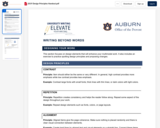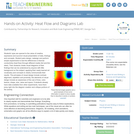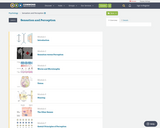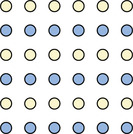
This handout introduces you to four principles for visual design: contrast, repetition, alignment, and proximity.
- Subject:
- Composition and Rhetoric
- English Language Arts
- Material Type:
- Reading
- Provider:
- Auburn University
- Date Added:
- 10/10/2022

This handout introduces you to four principles for visual design: contrast, repetition, alignment, and proximity.

Students' eyes are opened to the value of creative, expressive and succinct visual presentation of data, findings and concepts. Student pairs design, redesign and perform simple experiments to test the differences in thermal conductivity (heat flow) through different media (foil and thin steel). Then students create visual diagrams of their findings that can be understood by anyone with little background on the subject, applying their newly learned art vocabulary and concepts to clearly communicate their results. The principles of visual design include contrast, alignment, repetition and proximity; the elements of visual design include an awareness of the use of lines, color, texture, shape, size, value and space. If students already have data available from other experiments, have them jump right into the diagram creation and critique portions of the activity.

Psychology is designed to meet scope and sequence requirements for the single-semester introduction to psychology course. The book offers a comprehensive treatment of core concepts, grounded in both classic studies and current and emerging research. The text also includes coverage of the DSM-5 in examinations of psychological disorders. Psychology incorporates discussions that reflect the diversity within the discipline, as well as the diversity of cultures and communities across the globe.Senior Contributing AuthorsRose M. Spielman, Formerly of Quinnipiac UniversityContributing AuthorsKathryn Dumper, Bainbridge State CollegeWilliam Jenkins, Mercer UniversityArlene Lacombe, Saint Joseph's UniversityMarilyn Lovett, Livingstone CollegeMarion Perlmutter, University of Michigan


By the end of this section, you will be able to:Explain the figure-ground relationshipDefine Gestalt principles of groupingDescribe how perceptual set is influenced by an individual’s characteristics and mental state

Students learn the value of writing and art in science and engineering. They acquire vocabulary that is appropriate for explaining visual art and learn about visual design principles (contrast, alignment, repetition and proximity) and elements (lines, color, texture, shape, size, value and space) that are helpful when making visual aids. A PowerPoint(TM) presentation heightens students' awareness of the connection between art and engineering in order to improve the presentation of results, findings, concepts, information and prototype designs. Students also learn about the science and engineering research funding process that relies on effective proposal presentations, as well as some thermal conductivity / heat flow basics including the real-world example of a heat sink which prepares them for the associated activity in which they focus on creating diagrams to communicate their own collected experimental data.